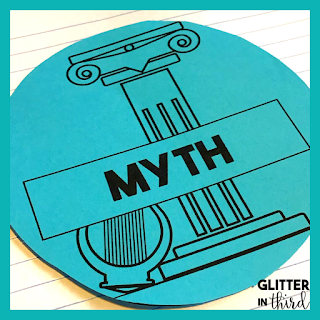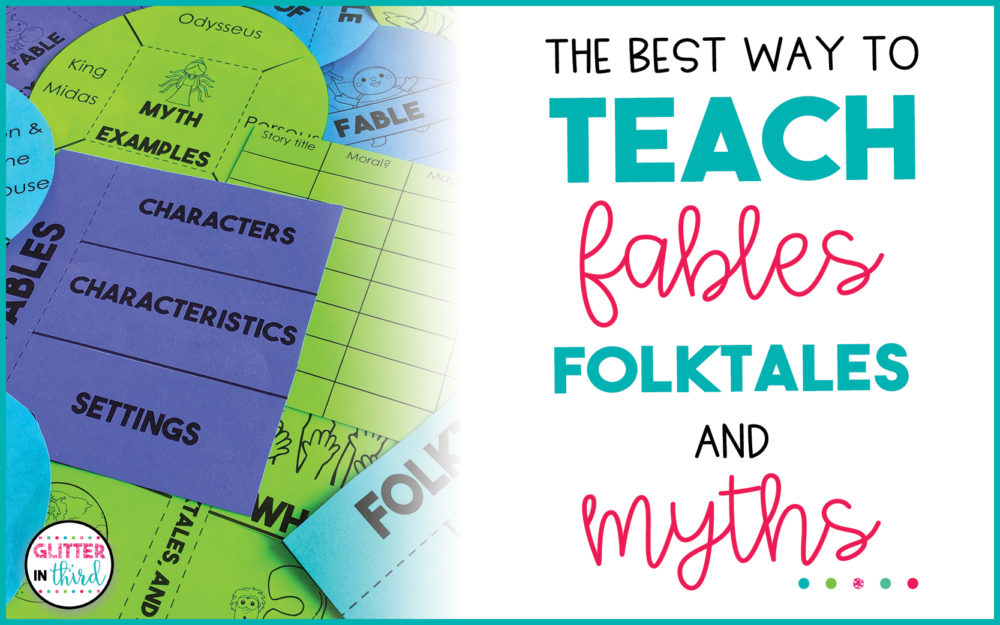Fables, folktales, and myths for 3rd grade
Are you a 2nd or 3rd grade teacher who teaches fables, folktales, and myths? This Common Core Standard RL 3.2, although fun, can be difficult to wrap your head around.
I want to share how I teach it in the classroom!
At the end of the post, don’t forget to download my Fables, Folktales, and Myths classroom signs!
There are some links to various books within the post. Please note that these are Amazon Affiliate links, so if you decide to purchase a book using them I receive a small commission that goes toward keeping this website running. However, you can always write down the name of the book and find it at your local bookstore!
Fables, Folktales, and Myths lessons in 3rd grade
You can definitely do these lessons with your own materials. If you’re
interested in saving time and
having the activities ready (woohoo no prep!), definitely take a peek at my
Fables, Folktales, and Myths interactive notebook.My favorite part about my
Fables, Folktales, and Myths interactive notebook is that it is:
- Differentiated
- Depending on the time in your classroom and ability of your students, you get choices for each activity. For example, you receive a blank and a filled-in version of all the example circle foldovers.
- Paper-saving
- Each activity is printed two to a page.
Introductory fables, folktales, and myths lessons
Fable introduction (can take 1-2 class periods)
Explain that we will be focusing for this unit on three types of folklore: myth, fable, folktale.
Pass out circle foldover to each student to put into their notebook. Explain to students that we will be focusing on the genre of folklore, specifically at myths, fables, and folktales. Students will also complete a sorting flipbook chart to learn about characteristics of folklore, like how they were orally passed down from generation to generation.
Sit students on the carpet. Explain that we will be discussing what a fable is. On the board/easel, make a quick chart with a category for: Characters, Settings, and Characteristics. Pick two fables to read (I would recommend The Tortoise and the Hare, and The Fox and the Grapes). Read to the class.
Ask the class:
- What do these stories have in common?
- Who are the main characters in the fables?
- Both the stories had a “moral” at the end… what was the moral of these stories?
- What do you think a moral is?
Explain that Aesop is the author and creator of fables.
Pass out and glue into notebook:
- Fable title page
- Fable examples circle foldover
- Students can fill these in as the unit goes on. For now, they can write down the two fables that you read in the beginning of the lesson.
Pass out and glue into notebook:
- All about fables sort
- Students will cut out boxes and sort the commonalities of the characters, setting, and characteristics
Now that your students know what a fable is, take advantage of these short stories. Pick a fable to read at Morning Meeting or right before your lesson every single day of the unit. Fables only take a few minutes to read, but the kids will love hearing them and it will help them truly understand what a fable is.
Folktale introduction (will take 1 class period)
Sit students on the carpet. Ask what
we learned about fables yesterday.Explain that we will be
discussing what a folktale is. On the board/easel, make a
quick chart with a category for:
Characters, Settings, and Characteristics. Pick one folktale to read (
I would recommend Jack and the Beanstalk by Steven Kellogg). Read to the class.
Pass out and glue into notebook:
- Folktale title page
- Folktale examples circle foldover
- Students can fill these in as the unit goes on. For now, they can write down the folktale that you read in the beginning of the lesson.
Pass out and glue into notebook:
- All about folktales sort
- Students will cut out boxes and sort the commonalities of the characters, setting, and characteristics
Myth introduction (will take 1 class period)

Sit students on the carpet. Ask what we learned about folktales and fables so far.
Explain that we will be discussing a new genre, a myth. On the board/easel, make a quick chart with a category for: Characters, Settings, and Characteristics. Pick two myths to read (my absolute favorite myth book is Usbourne Myths, it has a variety of short myths that don’t take long to read). If you do not have that book, you can check out a book on myths from the library, or find some quick ones to read online (like Arachne and Athena or Pandora’s Box). Read to the class.
Ask the class:
- What do these stories have in common?
- Who are the main characters in the myths?
Pass out and glue into notebook:
- Myth title page
- Myth examples circle foldover
- Students can fill these in as the unit goes on. For now, they can write down the two fables that you read in the beginning of the lesson.
Pass out and glue into notebook:
- All about myths sort
- Students will cut out boxes and sort the commonalities of the characters, setting, and characteristics
Fables, folktales, and myths additional lessons
Additional activity #1: Daily literacy center review
Go to your library, and check out about 20 picture books (roughly 5 of each genre, give or take a few extras!). Put the books into a basket. As a center, students will grab one of the picture books. They will read the book, then sort it as a fable, folktale, or myth and record it onto their sorting sheet.
Additional activity #2: Reading passages & comprehension questions
Do you have a
ReadWorks account? If not – get one ASAP. First of all, it is completely free. Secondly, it is amazing.
ReadWorks has passages and question sets. I love doing a one-a-day reading passage during my literacy centers to get my students thinking critically about their text. During my Fables, Folktales, and Myths unit, I always try to stick with these genres for the passages to stay on topic.
I made a list of some passages that are available on the site that will work great for this unit! For all the passages below, just type them into the Search bar on ReadWorks. The passages and questions sets will come up. From there, you can either print or assign to Google Classroom!
Fable reading passages:
- The Ants and the Grasshopper
- The Hen That Laid Golden Eggs
- The Lion and the Mouse
- The Crow and the Pitcher
- The Fox and the Crow
- The Hare and the Tortoise
- The Shepherd Boy and the Wolf
- The Wolf in Sheep’s Clothing
Folktale reading passages:
Myth reading passages:
- Ancient Greece – Greece Mythology
- Arachne the Weaver
Additional activity #3: creative writing
Time to write! Use the writing process for students to create their own fable, folktale, or myth. Remind students that they need to follow the characteristics of the genre that they choose.
I have students do the writing piece at the end of our fable, folktale, and myth unit. They need to fully understand what these three genres are in order to write one.
Need read-aloud ideas?
Fable, folktale, and myth signs
Want a set of signs to hang up in your classroom?
I have you covered!
Just click on the button below and I will send these signs to you for free!



